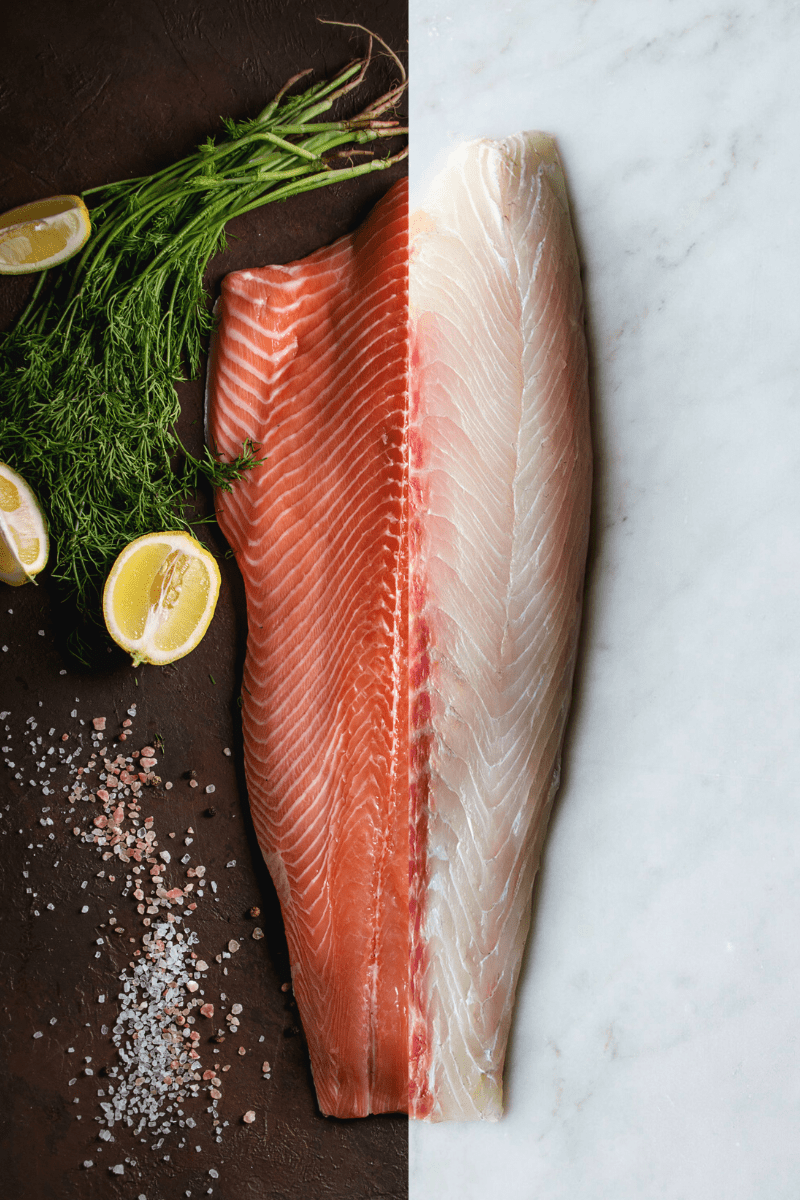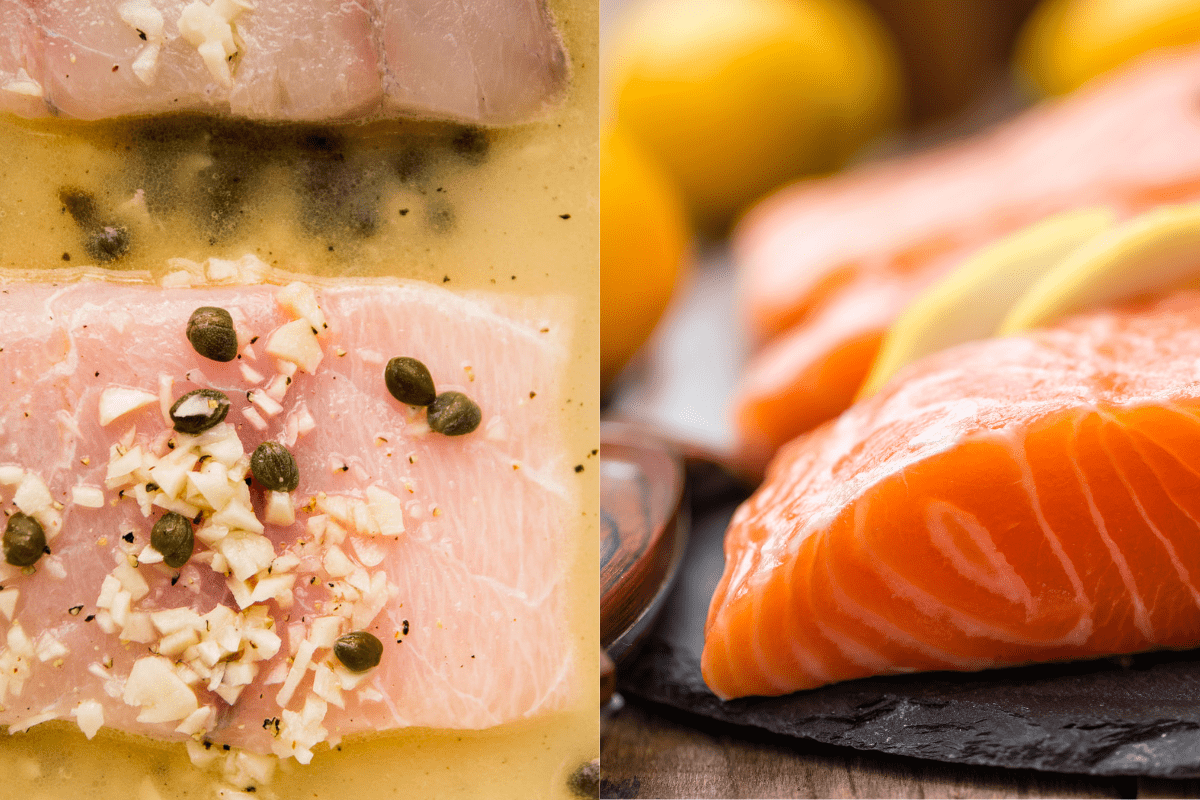Barramundi vs. Salmon: How do these fish stack up?

It’s well-documented that adding seafood to your weekly meal routine can offer important health benefits. But when it comes to getting a bigger variety of seafood in your diet, it’s tough to know when (or how) to try a brand new species of fish.
If you love salmon, but are feeling the urge to mix it up a little bit when it comes to weekly meal planning, barramundi might be your new favorite fish.
Barramundi vs. salmon: What’s the difference?
Salmon is well known for its beautiful pink color and meaty texture. Barramundi is a white fish with natural variations of pink and silvery gray. You can buy both fish in fresh or frozen format and in various cuts—from full fillets to ready-to-eat crispy fish tenders.
One species vs. many species
The biggest difference between these two fish is that barramundi refers to just one species (Lates calcarifer), while “salmon” encompasses many different species, like King salmon (Oncorhynchus tshawytscha), pink salmon (Oncorhynchus gorbuscha), sockeye (Oncorhynchus nerka), coho (Oncorhynchus kisutch), chum (Oncorhynchus keta), and Atlantic salmon (Salmo salar).
Salmon differs in size, texture, color, and flavor from species to species. Sockeye salmon, for example, is bright pink, somewhat smaller than its cousins, and relatively lean; King salmon can produce enormous fillets with a fatty, buttery, light pink color.
Barramundi can also vary in size, depending on whether it is farm-raised or wild-caught. Barramundi is the FDA-approved market name for this species in the U.S., but it’s also known as Asian sea bass or Giant sea perch in other parts of the world.
Farming and fishing differences
Farming and fishing methods also vary widely between salmon and barramundi.
At The Better Fish®, our barramundi comes from just one farm, in one location, and raised with sustainably-certified ocean farming practices.
Salmon, however, can have many different points of origin. Wild salmon typically comes from Alaska, where state law helps manage wild fish stocks in a sustainable way. Farmed salmon can come from a wide variety of salmon farming facilities located all around the world — and these fish farms can vary widely in quality, taste, and sustainability efforts.
Is barramundi healthier than salmon?
Salmon and barramundi are both great options as part of a healthy lifestyle!
While barramundi has half the calories of Atlantic farmed salmon, both fish are high in omega-3 fatty acids, which play a vital role in brain and heart health.
Health- and food-focused organizations like the USDA and NIH consistently recommend salmon as a good source of omega-3 fatty acids. Barramundi has a 25 percent ratio of omega-3s to total fat, giving it the highest level of omega-3 fatty acids of any commonly eaten white fish.
One JAMA-published study from the Harvard School of Public Health reports that wild salmon has 1,774mg of omega-3 fatty acids per 6 ounce serving, while farmed salmon has 4,504mg per 6 ounce serving. One 4-ounce serving of barramundi packs 650mg of omega-3s, which doubles if you also eat the skin.
Which has more protein?
Salmon and barramundi are both an excellent source of lean protein!
One 4-ounce serving of barramundi has 21 grams of protein, and one serving of salmon can have anywhere from 17-25 grams of protein (USDA), depending on the species and how it was raised or caught.
Is barramundi high in mercury?
The Better Fish® Barramundi contains no traceable levels of mercury or toxic polychlorinated biphenyls (PCB), and it’s farmed without any antibiotics or chemicals, which makes barramundi very safe to eat. Salmon also tends to have low mercury levels, although the presence of PCB and antibiotics can vary depending on where the salmon was caught or farmed.
The bottom line: Whether you choose salmon or barramundi at mealtime, you’re making a great choice for your health and longevity. Be sure to check out our barramundi recipe library for easy, nutritious recipes that don’t skimp on taste!
What does barramundi taste like?
Barramundi and salmon are both delicious, and they each have their own unique flavor profile.
Barramundi is a relatively mild fish: it’s mellow with a smooth, buttery, and subtly-sweet flavor, which means it pairs exceptionally well with strong sauces and won’t compete with other prominent flavors in a recipe. Barramundi is also flakier than salmon: it has more of a fall-apart, fork-tender texture that makes it feel especially decadent.
If you have a family member who doesn’t enjoy the strong taste of salmon, barramundi is a great “meet in the middle” option: it still packs a nutritious punch, but it has a mild flavor that doesn’t feel quite as “fishy.” If you tend to like other white fish (like cod, halibut, or tilapia) or love dishes like fish n’ chips or fish sandwiches, you’ll love the taste and texture of barramundi. It will feel very familiar to you!
Which one is easier to cook?
Barramundi and salmon are both sturdy and fairly forgiving, which makes them easy fish to cook at home. They’re great choices for beginners, or for anyone who gets a little nervous about cooking seafood!
Salmon is a hardy, versatile fish, so it’s difficult to accidentally mangle it or tear it apart. Salmon can have a strong odor, especially if it’s been in the fridge for a few days. If you don’t like the smell of raw fish, barramundi’s mild, not-at-all-fishy smell makes it a great choice for cooking at home.
Barramundi is a slightly smaller fish, which makes barramundi fillets a little more delicate than salmon. Still, barramundi holds together very well with just about any preparation, which makes it an easy introduction to cooking seafood at home.

Is barramundi more sustainable than salmon?
Barramundi and responsibly farmed or fished salmon are great choices if you’re looking for sustainable fish options.
The Better Fish® Barramundi is all farmed by the same company at just one location (Van Phong Bay, Central Vietnam), which makes it a very consistent fish that offers a transparent, sustainable, farm-to-table experience. We’re serious about environmental stewardship, and collaborate with leading ocean conservation organizations like Monterey Bay Aquarium, SeaWeb, and the WWF Aquaculture Stewardship Council to ensure barramundi is part of the solution to making food more sustainable.
Because salmon can be caught and farmed in so many different ways, it takes a little bit of legwork to make sure the salmon you’re getting is grown or fished with sustainability in mind.
When shopping for sustainable salmon, be sure to seek out Wild Alaskan Salmon (which is a great example of sustainable wild fishery management) or look for farmed salmon that has certifications from The Aquaculture Stewardship Council (ASC) such as Kvaroy Arctic. When in doubt at the grocery store, find the most up-to-date sustainable seafood recommendations with Seafood Watch!
Frozen vs. fresh fish
When fish is flash frozen — which means it’s frozen at a very low temperature that lets it solidify much more quickly than a standard home freezer — immediately after it’s caught or harvested, it locks in all of the nutrients and texture that help fish taste, well, fresh!
Barramundi is flash frozen within hours of harvest and transported fully frozen. Many salmon fishermen and salmon farms also flash-freeze their fish immediately after it’s caught or harvested—you can typically find this information on a company’s website!
It’s cheaper and more environmentally friendly to transport fish in its frozen state instead of shipping it fresh. Barramundi, for example, is shipped frozen in containers, which emits 90% less carbon than fresh fish flown by air.
Frozen fish also combats food waste (and saves money!) By storing fish in the freezer, you can pull it out as you need it instead of worrying it might be forgotten in the back of the fridge.
Which fish is more affordable?
Barramundi and salmon vary in price and availability, but both fish offer great value!
The Better Fish® Barramundi is farmed year-round, as is most farmed salmon, which makes it readily available and accessible at a consistent price point.
Wild salmon is typically only fished in the summer months, to coincide with salmon’s return to the ocean after breeding in freshwater. This seasonality, along with state laws that ensure sustainability by limiting how much fish can be caught, means wild Alaskan salmon can experience price fluctuations throughout the year. It may be easier to find fresh wild salmon during the summer or early fall than other months, though frozen wild salmon is usually available year round.
Frozen salmon and barramundi fillets are typically available at a lower price than fresh salmon fillets, which makes it easy to buy quality seafood at an affordable price.
In conclusion: barramundi or salmon?
Both of these fish are excellent, approachable, affordable options. It really comes down to your personal preference!
If you love the ease and versatility of salmon, but would like to eat a wider variety of fish, try adding farmed barramundi to the mix to supplement your favorite salmon recipes. Barramundi’s mild flavor also makes it a great choice for anyone who is trying to eat more fish but doesn’t necessarily like salmon.
If you prefer wild-caught salmon, barramundi is a great back-pocket option to have when wild salmon is out of season or if prices are higher than usual.
If you’re new to cooking seafood at home, but want to incorporate more of it into your diet, barramundi and salmon are both excellent, easy-to-cook choices that hold up well in a ton of different recipes. If you’re still a little apprehensive about seafood, barramundi’s mild flavor and buttery texture make it a great starting point for your seafood journey.